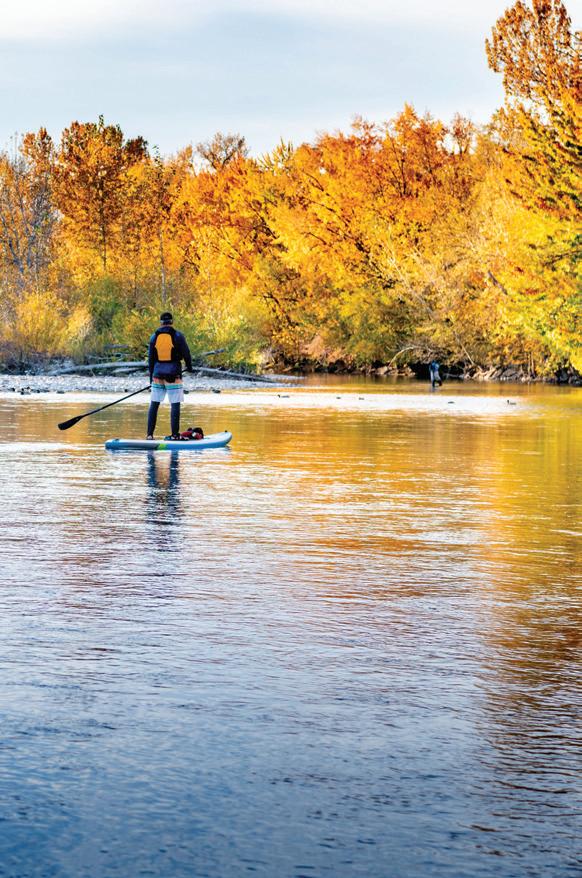
4 minute read
The Life Force of Boise
THE LIFE FORCE O F A PORTRAIT OF THE BOISE RIVER
B O I S E
Advertisement
BY HAYDEN SEDER
Cities are often compared to living organisms—entities that evolve and adapt. If the city of Boise is a living organism, then the Boise River that flows through it is certainly its lifeblood, critical to the survival of the greater organism, but with a life of its own.
The evolution of a river isn’t as noticeable as that of a city; indeed, it is sometimes only over the course of years, decades, lifetimes that one can see the shifts in a river. In his memoir Life on the Mississippi, Mark Twain describes the river as: a wonderful book—a book that was a dead language to the uneducated passenger, but which told its mind to me without reserve, delivering its most cherished secrets as clearly as if it uttered them with a voice. And it was not a book to be read once and thrown aside, for it had a new story to tell every day.
Like any river, the Boise River has many of its own stories to tell.
The Lower Boise River (henceforth the Boise River), one of multiple forks, is part of the Lower Boise River Watershed, a 836,876-acre (or 1,307 square mile) area encompassing farm land, city, rangeland and forest. The Boise River starts its journey at the Lucky Peak Dam and Reservoir southeast of Boise and flows northwest until it meets the Snake River west of Parma. These 64 river miles form what Boise residents call the Boise River, a source of recreation, quality of life, revenue and habitat for wildlife.
When thinking of the Boise River, many think of it as a spot for floating and tubing—after all, over 125,000 people float the river each year, according to Ada County Parks and Waterways. But the Boise River provides so much more than a leisurely way to get from point A to B in the city.
The Boise River Enhancement Network reports that the river has helped change the landscape of the Treasure Valley by providing a source of irrigation water, filtering and diluting pollutants, helping reduce floods and erosion, and providing habitat for numerous species of birds, fish and other wildlife. Native Americans used the river for water, transport, and fishing, and later, fur traders, prospectors and early settlers did the same.
Today, we no longer need the river for its historic purposes, but our present quality of life is better for it. The Boise River begins at the Lucky Peak Reservoir, an area used for swimming, picnicking, fishing, boating, water skiing and biking.
Head farther downriver to Barber Park and you’ll find the launching off spot for floating or tubing the river. Air stations are typically available to inflate devices (though due to COVID-19, the 2020 season did not have them) as are rentals for rafts, kayaks, and tubes and a shuttle. Float six miles downstream to the getout at Ann Morrison Park, a journey of roughly two hours.
While floating the river, you’re sure to see people jumping from one of the several bridges you pass under. Look alive if you’re floating—a recent rant published online complained of teenagers attempting to jump from bridges onto floaters, a punishable crime in the city of Boise.
At any point along the river, one may spot fisherman reeling in wild trout, stocked hatchery rainbow and brown trout, and steelhead in one of the best urban fishing rivers in the country. There
Hidden Languages

Streaming November 2020 thru April 2021
are numerous outfi tters and guides who get a substantial amount of revenue from taking people fi shing on the Boise River.
Running for 25 miles alongside the Boise River is the Boise Greenbelt, a tree-lined pathway that provides access to the river, pedestrian and cyclist access to riverside parks, and scenic views. e Greenbelt celebrated 50 years in 2019, a true community treasure.
Downstream from the fl oaters’ getout of Ann Morrison Park is the Boise Whitewater Park (originally known as the Boise River Park). is previously neglected portion of the river is now its own recreational powerhouse with a wave shaper device for surfi ng, kayaking and stand-up paddle boarding.
Underneath the surface, the river has even more stories to tell. Some Boise residents snorkel the river every summer in search of interesting lost items from fl oaters. One man has spent 16 years looking for objects and found items as mundane as sunglasses and keys and as surprising as a gun to a car. Oddly enough, two prosthetic legs have been found in the river on separate occasions, one in summer 2019 and another in 2020. Both times, the expensive appendages were successfully returned to their owners. A look at the Boise River Lost and Found Facebook page suggests that not all who have lost items in the river have been so lucky.
As one reaches the end of the Boise River, it is not truly the end but merely the conjoining of it with other bodies of water. Its life as an urban river, fl owing through the city of Boise, ends and the life of a wild, untamed one begins.
In Partnership With
A groundbreaking season of eleven bold world premieres, exclusive behind-thescenes fi lms, and highlights from favorite past performances.










